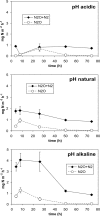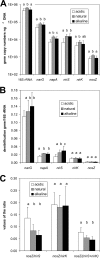Insights into the effect of soil pH on N(2)O and N(2) emissions and denitrifier community size and activity
- PMID: 20118356
- PMCID: PMC2838029
- DOI: 10.1128/AEM.02484-09
Insights into the effect of soil pH on N(2)O and N(2) emissions and denitrifier community size and activity
Abstract
The objective of this study was to investigate how changes in soil pH affect the N(2)O and N(2) emissions, denitrification activity, and size of a denitrifier community. We established a field experiment, situated in a grassland area, which consisted of three treatments which were repeatedly amended with a KOH solution (alkaline soil), an H(2)SO(4) solution (acidic soil), or water (natural pH soil) over 10 months. At the site, we determined field N(2)O and N(2) emissions using the (15)N gas flux method and collected soil samples for the measurement of potential denitrification activity and quantification of the size of the denitrifying community by quantitative PCR of the narG, napA, nirS, nirK, and nosZ denitrification genes. Overall, our results indicate that soil pH is of importance in determining the nature of denitrification end products. Thus, we found that the N(2)O/(N(2)O + N(2)) ratio increased with decreasing pH due to changes in the total denitrification activity, while no changes in N(2)O production were observed. Denitrification activity and N(2)O emissions measured under laboratory conditions were correlated with N fluxes in situ and therefore reflected treatment differences in the field. The size of the denitrifying community was uncoupled from in situ N fluxes, but potential denitrification was correlated with the count of NirS denitrifiers. Significant relationships were observed between nirS, napA, and narG gene copy numbers and the N(2)O/(N(2)O + N(2)) ratio, which are difficult to explain. However, this highlights the need for further studies combining analysis of denitrifier ecology and quantification of denitrification end products for a comprehensive understanding of the regulation of N fluxes by denitrification.
Figures




Similar articles
-
Changes in denitrifier abundance, denitrification gene mRNA levels, nitrous oxide emissions, and denitrification in anoxic soil microcosms amended with glucose and plant residues.Appl Environ Microbiol. 2010 Apr;76(7):2155-64. doi: 10.1128/AEM.02993-09. Epub 2010 Feb 12. Appl Environ Microbiol. 2010. PMID: 20154105 Free PMC article.
-
Effect of nitrogen and waterlogging on denitrifier gene abundance, community structure and activity in the rhizosphere of wheat.FEMS Microbiol Ecol. 2013 Mar;83(3):568-84. doi: 10.1111/1574-6941.12015. Epub 2012 Oct 17. FEMS Microbiol Ecol. 2013. PMID: 23006139
-
Variable response of nirK and nirS containing denitrifier communities to long-term pH manipulation and cultivation.FEMS Microbiol Lett. 2018 Apr 1;365(7). doi: 10.1093/femsle/fny035. FEMS Microbiol Lett. 2018. PMID: 29471521
-
Changes in bacterial denitrifier community abundance over time in an agricultural field and their relationship with denitrification activity.Appl Environ Microbiol. 2008 Oct;74(19):5997-6005. doi: 10.1128/AEM.00441-08. Epub 2008 Aug 8. Appl Environ Microbiol. 2008. PMID: 18689522 Free PMC article.
-
A review of stable isotope techniques for N2O source partitioning in soils: recent progress, remaining challenges and future considerations.Rapid Commun Mass Spectrom. 2008 Jun;22(11):1664-72. doi: 10.1002/rcm.3456. Rapid Commun Mass Spectrom. 2008. PMID: 18435506 Review.
Cited by
-
Interannual variation in nitrous oxide emissions from perennial ryegrass/white clover grassland used for dairy production.Glob Chang Biol. 2014 Oct;20(10):3137-46. doi: 10.1111/gcb.12595. Epub 2014 May 22. Glob Chang Biol. 2014. PMID: 24706411 Free PMC article.
-
The impact of a pulsing groundwater table on greenhouse gas emissions in riparian grey alder stands.Environ Sci Pollut Res Int. 2015 Feb;22(4):2360-71. doi: 10.1007/s11356-014-3427-1. Epub 2014 Aug 16. Environ Sci Pollut Res Int. 2015. PMID: 25124475
-
Impacts of natural factors and farming practices on greenhouse gas emissions in the North China Plain: A meta-analysis.Ecol Evol. 2017 Jul 21;7(17):6702-6715. doi: 10.1002/ece3.3211. eCollection 2017 Sep. Ecol Evol. 2017. PMID: 28904752 Free PMC article.
-
Edaphic factors and plants influence denitrification in soils from a long-term arable experiment.Sci Rep. 2020 Sep 29;10(1):16053. doi: 10.1038/s41598-020-72679-z. Sci Rep. 2020. PMID: 32994429 Free PMC article.
-
Functional regimes define the response of the soil microbiome to environmental change.bioRxiv [Preprint]. 2024 May 28:2024.03.15.584851. doi: 10.1101/2024.03.15.584851. bioRxiv. 2024. Update in: Nature. 2025 Jul 16. doi: 10.1038/s41586-025-09264-9. PMID: 38559185 Free PMC article. Updated. Preprint.
References
-
- Adams, T. M., and S. N. Adams. 1983. The effects of liming and soil pH on carbon and nitrogen contained in the soil biomass. J. Agric. Sci. 101:553-558.
-
- Arah, J. R. M. 1997. Apportioning nitrous oxide fluxes between nitrification and denitrification using gas-phase mass spectrometry. Soil Biol. Biochem. 29:1295-1299.
-
- Baudoin, E., L. Philippot, D. Chèneby, L. Chapuis-Lardy, N. Fromin, D. Bru, B. Rabary, and A. Brauman. 2009. Direct seeding mulch-based cropping increases both the activity and abundance of denitrifier communities in a tropical soil. Soil Biol. Biochem. 41:1703-1709.
-
- Cavigelli, M. A., and G. P. Robertson. 2000. The functional significance of denitrifier community composition in a terrestrial ecosystem. Ecology 81:1402-1414.
Publication types
MeSH terms
Substances
LinkOut - more resources
Full Text Sources
Miscellaneous

